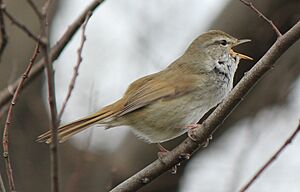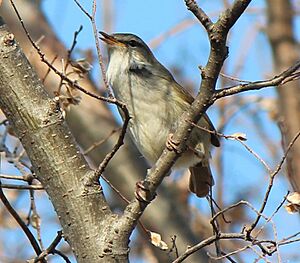Japanese bush warbler facts for kids
Quick facts for kids Japanese bush warbler |
|
|---|---|
 |
|
| Conservation status | |
| Scientific classification | |
| Genus: |
Horornis
|
| Species: |
diphone
|
| Synonyms | |
|
Cettia diphone |
|
The Japanese bush warbler (Horornis diphone), called uguisu in Japanese, is a small Asian passerine bird. You will probably hear its amazing song more often than you see the bird itself! Its special song can be heard all over Japan when spring begins.
Contents
What Does It Look Like?
The Japanese bush warbler has an olive-brown back. Its belly is a bit darker. It also has pale eyebrows. Its beak curves up, making it look like it's smiling! This bird is usually about 15.5 centimeters (about 6 inches) long.
Where Does It Live?
The Japanese bush warbler lives in Japan all year, except for the northern island of Hokkaidō. It also lives in the northern Philippines. In summer, you can find it in Hokkaidō, Manchuria, Korea, and central China. In winter, it moves to southern China and Taiwan.
This bird was brought to Oahu in Hawaii between 1929 and 1941. Since then, it has spread across the main Hawaiian Islands.
In summer, these birds live in low hills and high mountains. They like places with bamboo plants and black pine trees. In winter, they move to lower areas to find shelter.
How People Interact with This Bird
The Japanese bush warbler loves to sing. Because of this, people have often kept them as pet birds in cages. To encourage them to sing, people would cover the cages with a wooden box. This box had a small paper window that let in only a little light.
In Japan, people see the bush warbler's call as a sign that spring is coming. It's like how the return of the barn swallow signals spring in other places.
The Warbler in Japanese Culture
The Japanese bush warbler is a favorite subject in Japanese poetry. It appears in many famous poems, like those in the Man'yōshū and Kokin Wakashū collections. In special Japanese poems called haiku and renga, the word uguisu is a "season word" (called kigo). It helps show that the poem is about early spring.
In poetry, this bird is often linked with the ume (plum) blossom. You can even see the warbler with ume blossoms on hanafuda playing cards. There's also a popular Japanese candy called Uguisu-boru (Uguisu Balls). These brown and white candies look like ume flower buds. However, the warbler's famous song is usually heard later in spring, after the ume blossoms have already faded. In haiku, the bird with this later song is called sasako, and its song is called sasanaki.
The beauty of its song led people to call it the "Japanese Nightingale" in English. But this name is not used much anymore. This is because the European nightingale sings at night, and the Japanese bush warbler does not.
An uguisu-jō is a woman who works as an announcer. You might hear them at Japanese baseball games. They also advertise products and sales with a microphone outside stores. These women are chosen because they have beautiful, "warbling" voices. They also make public announcements for politicians before elections.
Nightingale Floors
In Japanese buildings, there's a special type of floor called uguisubari. This is often called a "nightingale floor" in English. These floors are made so that they squeak when someone walks on them. The squeaking sound is a bit like the Japanese bush warbler's soft chirping. These floors were designed to warn people sleeping inside if a ninja was approaching! You can see examples of these floors at Eikan-dō Zenrin-ji temple, Nijō Castle, and Chion-in temple in Kyoto.
Traditional Uses
The droppings of the nightingale (called Uguisu no fun) have been used for a long time in Japan. They contain a special enzyme. This enzyme was used to make skin look brighter and to help remove small wrinkles. Sometimes, it is sold as "uguisu powder." The droppings are also used to clean stains from traditional Japanese clothes called kimono.
Songs
- Pi pi pi... kekyo kekyo Hooo- hoke'kyo Hoohokekyo. Young Japanese bush warblers don't sing this "hoohokekyo" song perfectly at first. But they learn to sing better by listening to and copying other warblers nearby.
- Hooo- hokekyo, hooo- hokekyo. You can hear the songs of two Japanese bush warblers in this recording.




